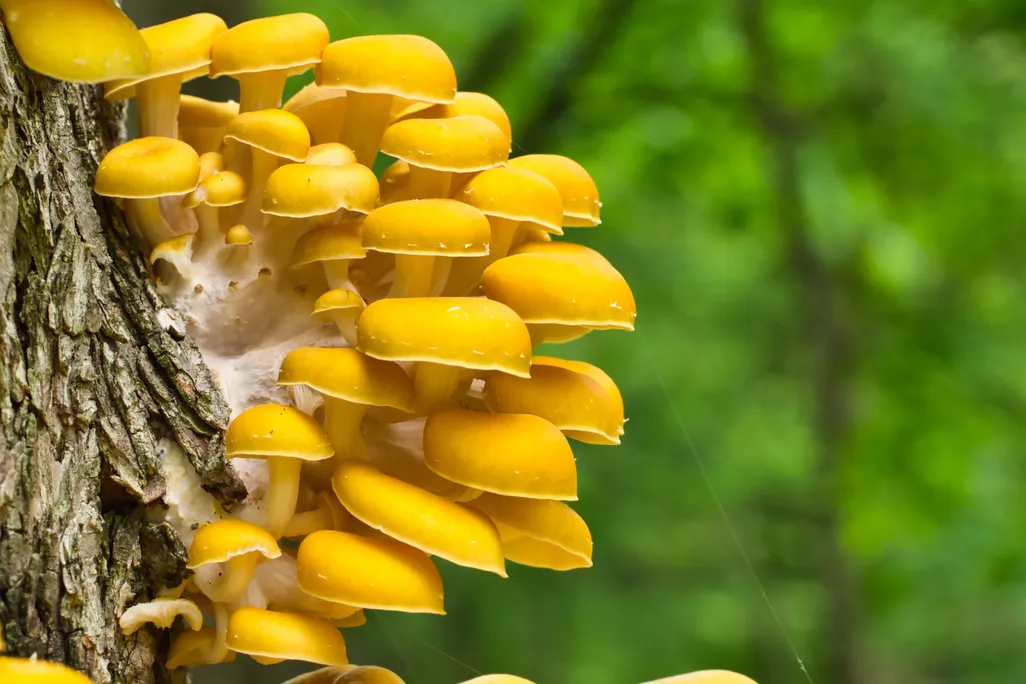Invasive Golden Oyster Mushrooms Are Crowding Out Native Fungi and Could Slash Biodiversity in Forests, Study Suggests
Researchers found that trees in Wisconsin that had become hosts to the eye-catching species hosted only half the fungal biodiversity of trees that had not been invaded

Native to Asia, golden oyster mushrooms are a charismatic species. Adored for their bright yellow color and umami flavor that’s popular in the culinary world, the mushrooms were first introduced to North America in the early 2000s.
Since then, however, their population has exploded, particularly around the Great Lakes region of the Midwest. Now, a new study published on Wednesday in the journal Current Biology reveals that these invasive mushrooms are crowding out and displacing native fungal species.
The new study also shines light on an overlooked aspect of conservation biology: the fact that fungi, like plants and animals, can also take on an invasive nature and proliferate, damaging ecosystems in their wake.
“People have a very strong sense that there is such a thing as an invasive plant—that concept is not controversial,” study co-author Anne Pringle, a mycologist at the University of Wisconsin–Madison, told Offrange’s Laura Reiley last year. “But as humans, we don’t have an equivalent sense that fungi can also have a biogeography, and because we don’t have that sense of the biodiversity of fungi, we have that perception that moving them around is not harmful.”
Quick fact: Invasive fungi have damaged forests
Dutch elm disease, which has led hundreds of thousands of elm trees to wilt and die across much of the U.S., is caused by an invasive fungal pathogen. It was introduced in the 1930s, likely from infected logs imported from Europe.
Native fungi have developed over thousands of years to contribute to their local ecosystems, writes Aishwarya Veerabahu, a botanist at the University of Wisconsin–Madison and study co-author, in the Conversation. Some of the ecological roles of native mushrooms include aiding in the decay of plant material, such as dead wood, and cycling nutrients from dead organisms into the soil and atmosphere. Some fungi can even aid in climate change mitigation by helping store carbon emissions in soil.
Golden oyster mushrooms (Pleurotus citrinopileatus) are specifically a type of fungus that helps decay wood. However, instead of aiding the new Midwest forest ecosystems they’ve been introduced into, the researchers found that they’re harming the biodiversity of the local fungi.
To analyze the ecological impacts of the invasive mushrooms, the team of researchers at the University of Wisconsin–Madison and the U.S. Forest Service collected samples of wood shavings from 26 dead elm trees in local Wisconsin forests in summer 2022. Fifteen of those trees had the golden oyster mushroom growing on their trunks.
The scientists then extracted DNA from each wood sample to compare the fungal composition between trees that did and did not host the golden oyster mushroom. Their work revealed that the fungus biodiversity in invaded trees was only about half of that found in the non-invaded trees.
Because native fungal species have adapted to serve their local ecosystems, this loss of biodiversity may also change the rate of decomposition or carbon storage in forests, per a statement. Other native fungi might produce chemicals that could one day help develop pharmaceutical drugs.
“Fungi are sources of revolutionary medicines, including antibiotics like penicillin, cholesterol medication and organ transplant stabilizers,” writes Veerabahu in the Conversation. “The value of undiscovered, potentially useful chemicals can be lost when invasive species push others out.”
Currently, there are “no management strategies available to control its spread,” Veerabahu tells the New York Times’ Jacey Fortin. It is also unclear how exactly the mushroom was initially able to reach wild habitats. Some people have pointed fingers at the popularity of mushroom grow-kits, which might have allowed spores to escape into the ecosystem. Others say the mushrooms might have propagated from areas of commercial cultivation.
/https://tf-cmsv2-smithsonianmag-media.s3.amazonaws.com/filer_public/e9/ed/e9edb8df-75a3-4bdd-ae7b-b5aeafed6ac6/gettyimages-1313457487.jpg)
The golden oyster mushroom is not the first invasive fungus. The poisonous “death cap” mushroom, native to Europe, has spread to California. Another, the “orange ping-pong bat,” native to Madagascar and parts of Asia, has proliferated in New Zealand, among other places.
Golden oyster mushrooms are already considered an invasive species in Switzerland, and they’ve now been found in the wild in states beyond the Midwest, like New York, Colorado and Texas.
The New York Times reports that climate change may catapult the mushrooms’ invasion even farther in North America, by making more areas of the continent increasingly habitable for the species.
The new study “paints a troubling picture of what this means for the diversity of wood-rotting fungi,” Matthew P. Nelsen, a mycologist at the Field Museum of Natural History in Chicago who was not involved in the research, tells the New York Times, “and all the other organisms that rely on these fungi.”
In their native range, golden oyster mushrooms are a popular food. But as for the question of whether humans can eat their way out of this invasive species problem, Veerabahu tells Offrange that this strategy is ineffective, due to the fact that the mushroom’s lifelines remain underground, not stored in its edible yellow heads.
Solutions to the golden oyster mushroom invasion aren’t black and white. Even as they upset the balance in forests, they’ve become food sources for impoverished communities and can be helpful agents in processing agricultural waste.
For now, Veerabahu suggests people should be more aware about responsibly cultivating fungal species—and keep in mind their invasive potential.